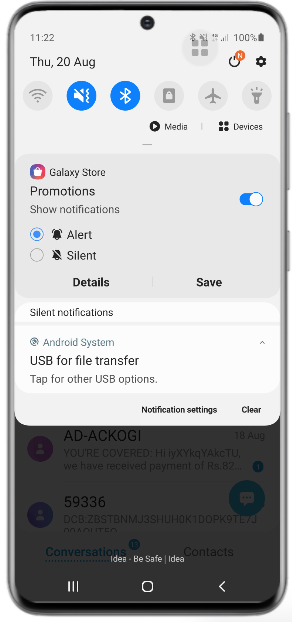App push notifications have been here for a while and have become a part and parcel of our daily lives, from alerting us about breaking news, notifying us about an interesting article, or even acting as a reminder. But somewhere down the lane, some marketer out there crosses the line and all hell breaks loose.
On average, US mobile user receives 46 app push notifications per day. And that is a lot. Some marketers exploit users by spamming them to death and at the same time cribbing the engagement results that they get. I know, what an irony.
But here is the thing, users want to receive relevant notifications from you, something that can provide them value. But constant pings can make it annoying. Lucky for you, rather than opting out of notifications, or God forbid uninstalling the app, the users can choose to turn the push notifications to be delivered silently.
Table of Content
- What are silent notifications?
- How can users enable silent notifications on Android?
- How can users enable silent notifications on iOS?
- What are Persistent notifications?
- Data and background notifications
- To sum it up
What are silent notifications?
Silent notifications are notifications that do not make any sound or alert the user when it arrives, but it gets displayed only in the notification center/notification tray. This ensures that the users get the information without being interrupted, and can go through the push notifications at a time that is convenient for them.
There are two ways of looking at this-
- This increases the chances of readers engaging with the notifications since they are browsing in their spare time at hand.
- Since the notifications do not alert the user when they get delivered, it also means that time-sensitive notifications go for a toll. For example, a reminder to join an online event is missed by the user.
Users can mute notifications on both Android and iOS, for better user experience by getting the most out of push notifications.
Note: Silent notifications do not appear on the lock screen.
- iOS provides functionality to swipe up on the lock screen to visit the notification center. Silent notifications will appear in such cases.
- The app icon in System Status Bar has no impact and appears upon each delivery on Android.
How can users enable silent notifications on Android?
There are two ways users can receive silent push notifications on Android.
Users can long press on a notification to get an option to display notifications silently.
 Users can also enable silent notifications by heading to Settings > App & Notifications > Search for app and choose> Notifications, and turn it off.
Users can also enable silent notifications by heading to Settings > App & Notifications > Search for app and choose> Notifications, and turn it off.
How can users enable silent notifications on iOS?
Turn notifications of a particular app to deliver quietly by swiping the notification slightly to the left and then click on Manage and select Deliver Quietly.
-2.gif?width=321&name=ezgif.com-video-to-gif%20(1)-2.gif)
Users can opt to receive silent push notifications on iOS also by going to the Settings > Notifications> and by clicking on the app you want the notifications to be delivered silently. The notification preview for Lock Screen and Banners must be disabled leaving only Notification Center enabled. Sounds and Badges can also be disabled in order to have a quiet experience.
A user has the choice to either choose to receive notifications quietly or with an alert. Here the power lies with the users and the app developer can not do anything to reverse this. This is also why marketers need to make sure that the notifications they send are relevant to the user so that they don’t end up being muted.
What are Persistent notifications?
Persistent notifications can not be dismissed and are silent in nature though it is being sent by the developer. Persistent notifications are passive notifications and do not require interaction from the user and are usually triggered to keep the users informed about their activity inside the app once they move away from it. Google removed the ability to dismiss persistent notifications, but these might reappear with Android 11.
.png?width=650&name=1504797550-picsay.png.pagespeed.ce.8gFaPBnl1G%20(1).png)
A good example of persistent notifications would be Google maps, which notifies you about the traffic in your area. Or the notification that prompts you about the weather. These notifications would only populate if for example an active navigation route is set and then you move away from the app. The notification automatically disappears once the app is closed.
Data and background notifications
The sole purpose of background notifications is to pre-load content in your app. There are times when a user does not launch an app for extended periods of time, which makes the app data outdated. This leads to a delay in the app load when the app is launched by the user. Background notifications provide a way to counter this and also help in improving the UX by waking up the app periodically, ensuring that the outdated data gets replaced with the new ones, and making the app launch smooth and frictionless.
Background notifications are also used to track uninstalls and keep the user base valid. Data notifications can be delivered prominently or in the background, which is up to the developer to decide. If they are sent in the background, these notifications are not visible to the user. This also means that the user is unaware of the notification being delivered and cannot see the content. On the other hand background, notifications can be delivered prominently with the help of content notifications.
Background notifications on iOS
Background notifications on iOS can be combined with content notifications, which is beneficial when a user on iOS has not opened an app for a considerable period of time. Background notification will not update the data if the app is swiped away. In such cases, content should be presented to the user so that the app can open in background and process. When a background notification is delivered to the user, iOS wakes up the app in the background and gives it 30 seconds to run.
Background notifications on Android
Background notifications on Android can not wake Android apps that have been forced-quitted in the app settings, which requires one to send a background notification along with a content notification.
To sum it up
Content notifications can be converted into silent notifications by the reader. The app developer has no power over this. While this is all hunky-dory you should send out relevant, thumb-stopping notifications so that users prefer to receive an alert than just being another notification in the sea of notifications.
Persistent notifications are passive notifications that are just present to aid users. Data/Background notifications can be sent both silent and prominent to the users by the developer to improve the app experience or to gather app uninstalls.
If you want to know more about push notifications and how you can most of it to engage your audience, just ping us on chat.





